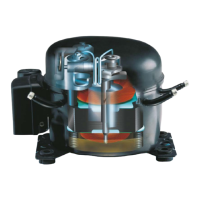16
4.8
Brazing methods and
requirements
4.8.1
Filler Metal and Flux
4.8.2
Corrosion
The refrigeration and air conditioning industries depend on brazed copper tubes as a leak proof carrier for
pressurized refrigerant. The common approach to brazing copper to copper or copper to steel is to use filler
metal (copper alloy). Torch brazing with oxygen/fuel gas (acetylene in most cases) is standard practice in
heating these connections.
Two brazing methods are used
• With filler metal and flux
• With filler metal only
Basic requirements to have a good brazing connection
• Filler metal flows easily when clearance uniform and tight, between 0.038 mm and 0.076 mm /
0.0015 inch and 0.003 inch
• The wide 0.5 mm / 0.02 inch clearance severely limits the flow.
• The overlap need to be about 4 to 9 times of the tube thickness and is a function of the tube thickness
and required strength of the joint.
Filler metal
Two types of filler rods are used for brazing copper tubes. These fillers are:
• Phosphorus – copper brazing alloys with melting point around 704 °C / 1300 °F and this temperature
depends on the alloy composition.
When phosphorus content reaches 8.37%,
the melting point is 710 °C / 1310 °F.
Lower phosphorus content is needed when the clearance is greater than 0.127 mm / 0.005 inch.
Caution: Alloys containing phosphorus should not be used to braze copper – steel joints.
These alloys should not be used on Secop compressors with steel copper coated connecting tubes.
The joint will not have sufficient ductility for high vibration application (compressor).
• High silver filler metal should be used to braze the copper-steel joints or other ferrous base metals.
The best are 40%; 45% and 56% silver rods.
• With optimum clearance, many brazing filler metals are suitable. It is necessary to heat only the joint to
suitable temperature above filler metal melting point.
Flux
• Fluxes are not designed for the removing oxides, coatings (in our case – painting tubes), oil, grease, dirt,
or other foreign materials from the tubes to be brazed. Prior to brazing, all parts must be subjected to
appropriate cleaning operation. The main function of flux is to make sure that the filler metal flows freely
through the brazing joint.
• Oxides are the principal source of surface contamination. The dissolution and removal of oxides during
brazing are also a function of a flux.
• The flux must also be fluid and displace readily by the molten brazing filler metal So as not to impair
metal flow.
• Wetting ability and viscosity of a flux at brazing temperature, therefore, are important properties.
• Some filler metals such as silver and phosphorus are self-fluxing.
• Flux residue generally should be removed to avoid corrosion from the remaining active chemicals.
The residue obtained from the flux, particularly when considerable oxide removal has occurred, is a
form of glass. Less formation of glass makes for easier flux residue removal. Removing flux from
properly cleaned, brazed tubes can usually be accomplished by washing in hot water accompanied by
light brushing. Preferably, this rinse should be done immediately after brazing operation. drying is highly
recommended after rinsing.
The type of corrosion affecting brazed joints are often similar to those acting upon the base metal and their
alloys. Brazed joints experience corrosion caused by environment, geometric factors, microstructure, or
composition of the brazed joint. The basic corrosions are:
• Galvanic corrosion
• High temperature corrosion
• Cracking complicated by corrosion
Galvanic corrosion can be a major concern because the brazed joints consists often a bond between dis
-
similar base and filler metal. If the braze is immersed in an electrolyte, galvanic corrosion may occur. The
electrolyte may be as simple as water. If flux is used and the customer is using water to clean the joint, they
create the electrochemical reaction. The distances between the anodic and cathodic reactions are on atomic
scale. The worst case scenario is using acid for cleaning the surface. We should remember that water is also
present in brazing fluxes either as water of hydration or separate addition for the purpose of making a paste
or liquid.

